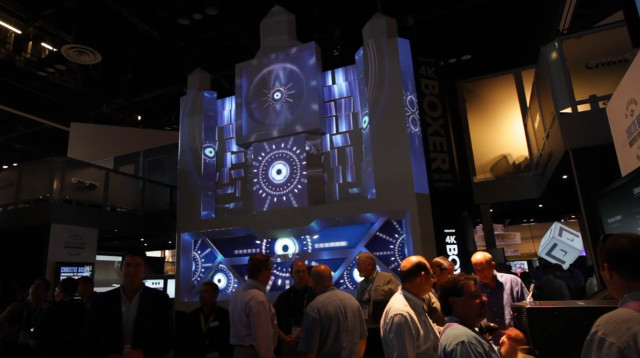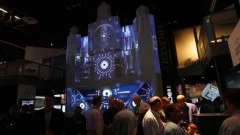There were really no new product announcements in projection for Christie at Infocomm this year, so they mostly showed applications. One new innovation was an update to the company’s AutoStack camera-based alignment solution of warp and blend and projection mapping applications.
We took a brief video of the projection mapping demo they were using with model buildings and projectors (Christie Shows Fast Calibration Tool for Projection Mapping). Christie AutoStack, aimed at flat screens, supports up to a 2-by-3 blended array of projectors that can be stacked for a total of 12 projectors. AutoStack Premium is aimed at larger flat or curved/cylindrical and portrait display screens. It works on even larger screens as long as the selected camera and lens combination ‘sees’ the entire projected area. They both support a variety of cameras and lens options, which are pre-calibrated as a pair to ensure maximum results.
Christie AutoStack and Christie AutoStack Premium work in conjunction with Christie Twist, and support all M Series, J Series, Boxer, D4K and Roadie 4K 3DLP projectors.
Christie AutoStack at a glance:
- Camera-based system auto-calibrates warps and blends images on flat surfaces in less than two minutes per projector, compared to hours with traditional methods.
- Up to a 2-high by 3-wide blended configuration can be stacked for a total of 12 projectors.
- Intuitive user interface with step-by-step process and real time camera feedback.
- Overcomes off-angle/keystone issues for a perfectly framed image every time.
- Constant brightness overlaps between projectors in array.
- Delivers seamless displays in large-scale multi-projector setups.
Christie AutoStack Premium delivers all the benefits of AutoStack and:
- Expands the capabilities of AutoStack by auto-calibrating and blending images on flat, curved/cylindrical (with a curvature of up to plus/minus 70 degrees) and portrait orientation surfaces in less than two minutes per projector.
- When a single camera sees all projectors being used in its field of view, it allows more than 12 projectors to be used in an array.
Christie also showed a “scope” aspect ratio projected image, but this is mere obtained by cropping a FHD image to a resolution of 1920×720. While this is kind of cheating, it does offer a very wide aspect ratio with starts to look like two blended projectors, albeit with lower resolution. Nevertheless, it may work well in many applications.
Most other projector news was released at NAB (Christie Shows New Projectors at NAB), where we discussed their new RGB laser head models, called Freedom. This series offers two projector heads (the PROAV focused D4K60LH model and a Simulation focused Mirage 4KLH) and laser light sources that can be added in 5K lumen increments up to 60K lumens.
Also new was the D series of 3LCD projectors covering the 6-8K lumen range and a new ultra short throw lens at 0.38:1 for the company’s Q series of projectors. It is available now for $7,500. The Q series is the company’s laser-phosphor line with models from 3500 to 12K lumens.

Christie is also enjoying success with its Boxer projector – a 4K, 30K lumen model that runs on single phase power.
One area that is still in R&D is a solution to the color gamut concerns of laser-phosphor projectors. Such units are typically red deficient, like UHP lamps. Wide color gamut, such as the DCO-P3 gamut are possible, but at the sacrifice of optical efficiency. As a result, Christie is working on a red-boost solution. While they would not disclose what they are looking at, most approaches seem to be focused on adding a red phosphor to the phosphor wheel or adding a red laser or LED to the engine. We should expect news on this front by the end of the year.
(See our separate article on Christie-s direct view displays – Christie Emphasises Fill Factor for LED.)

